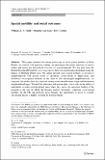Files in this item
Spatial mobility and social outcomes
Item metadata
| dc.contributor.author | Clark, W.A.V. | |
| dc.contributor.author | van Ham, M. | |
| dc.contributor.author | Coulter, R. | |
| dc.date.accessioned | 2015-03-19T16:01:01Z | |
| dc.date.available | 2015-03-19T16:01:01Z | |
| dc.date.issued | 2014-11 | |
| dc.identifier | 175343484 | |
| dc.identifier | 23cebbb1-dbca-44dd-b3d7-e2e2b2860885 | |
| dc.identifier | 84919389849 | |
| dc.identifier.citation | Clark , W A V , van Ham , M & Coulter , R 2014 , ' Spatial mobility and social outcomes ' , Journal of Housing and the Built Environment , vol. 29 , no. 4 , pp. 699-727 . https://doi.org/10.1007/s10901-013-9375-0 | en |
| dc.identifier.issn | 1566-4910 | |
| dc.identifier.other | ORCID: /0000-0002-2106-0702/work/64697561 | |
| dc.identifier.uri | https://hdl.handle.net/10023/6269 | |
| dc.description | The research reported in this paper was made possible through the financial support of the Marie Curie programme under the European Union's Seventh Framework Programme (FP/2007-2013) / Career Integration Grant n. PCIG10-GA-2011-303728 (CIG Grant NBHCHOICE, Neighbourhood choice, neighbourhood sorting, and neighbourhood effects). The authors also acknowledge the UK Economic and Social Research Council (ESRC RES-074-27-0020). | en |
| dc.description.abstract | This paper examines the nature and extent of socio-spatial mobility in Great Britain. In contrast with previous studies, we investigate the entire spectrum of moves within and across the hierarchical structure of neighbourhoods. We use data from the British Household Panel Survey to trace moves between neighbourhoods defined using the Indices of Multiple Deprivation. We define upward socio-spatial mobility as moving to neighbourhoods with greater levels of advantage (lower levels of deprivation), and downward socio-spatial mobility as the shift to less advantaged neighbourhoods. As expected, the results show that there are strong associations between origin and destination neighbourhood types. We find that education and income play critical roles in the ability of individuals to make neighbourhood gains when they move. An important finding of the research is the way in which the housing market structurally conditions socio-spatial mobility. In the UK and probably more broadly, the opportunity to move to socially advantaged places is highly stratified by housing tenure. | |
| dc.format.extent | 29 | |
| dc.format.extent | 708085 | |
| dc.language.iso | eng | |
| dc.relation.ispartof | Journal of Housing and the Built Environment | en |
| dc.subject | Residential mobility | en |
| dc.subject | Residential sorting | en |
| dc.subject | Socio-economic status | en |
| dc.subject | Deprivation | en |
| dc.subject | Neighbourhoods | en |
| dc.subject | GF Human ecology. Anthropogeography | en |
| dc.subject.lcc | GF | en |
| dc.title | Spatial mobility and social outcomes | en |
| dc.type | Journal article | en |
| dc.contributor.sponsor | Economic & Social Research Council | en |
| dc.contributor.institution | University of St Andrews. Geography & Sustainable Development | en |
| dc.identifier.doi | 10.1007/s10901-013-9375-0 | |
| dc.description.status | Peer reviewed | en |
| dc.identifier.grantnumber | RES-074-27-0020 | en |
This item appears in the following Collection(s)
Items in the St Andrews Research Repository are protected by copyright, with all rights reserved, unless otherwise indicated.

